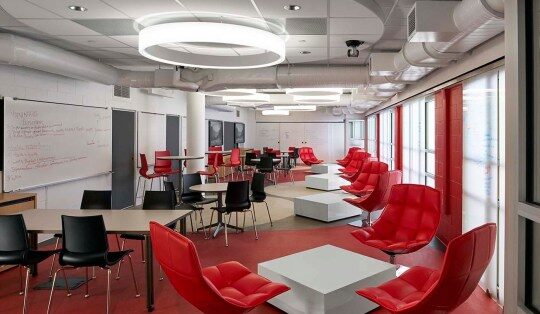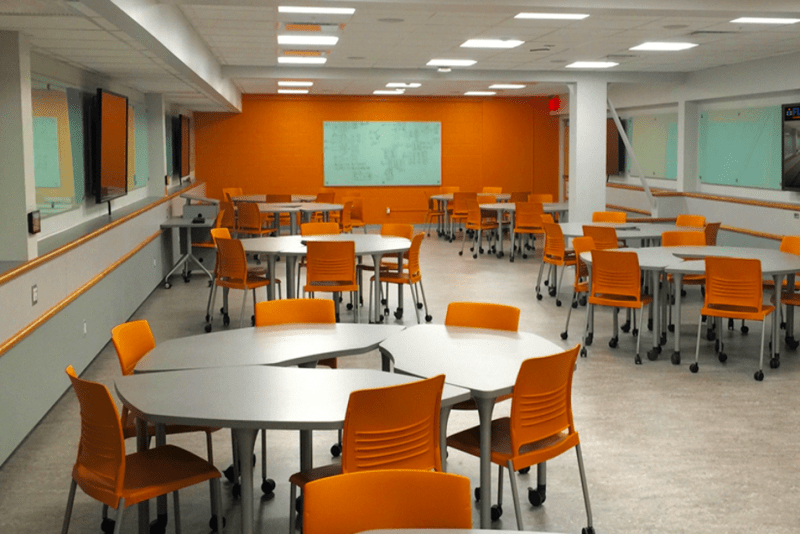Transitional rooms are a great way to transition into teaching in an interactive classroom. Wheeled tablet armchairs can easily transform eyes-front lecture into peer-to-peer small groups. Large tablet arms on these chairs may be combined to form temporary table tops for group discussions and practice activities. Transitional rooms are roomier than traditional classrooms so faculty and students can circulate easily for feedback and idea sharing, and they have multiple writing surfaces for brainstorming or working out problems. Transitional rooms support a variety of teaching and learning strategies but are designed to encourage less lecturing and solo activities, and more discussion-based activities with group interaction.
Gather rooms help you discover new ways of teaching in interactive classrooms. Wheeled tables and chairs–prearranged in groups–encourage shorter lectures interspersed with longer periods of group interaction. Gather rooms have shared tables and multiple writing surfaces to support a wide variety of project-based learning activities with ample room for faculty and students to circulate and share ideas. In smaller rooms the tables and chairs may be reconfigured in different ways for different activities, or moved out of the way for large group events. Gather rooms support all teaching and learning strategies but are ideal for discussion sections or hybrid courses where class time is intentionally used for peer-based learning and small group projects.
Turn and Talk interactive classrooms offer the best of both worlds: eyes-front orientation for lectures, and turn-and-talk seating for small group interaction. Turn and Talk rooms feature wider aisles that allow students to comfortably turn in their chairs and work with the row behind them, and portable whiteboards for table top brainstorming. Faculty may move easily between flat or tiered rows to offer feedback, or present ideas from a traditional front of the room. Turn and Talk rooms support a variety of teaching and learning strategies but are ideal for balancing lecture-heavy content with small group discussions, practice problems, team challenges, and group projects.

Tiered Pods
Tiered Pod rooms offer traditional front-of-room orientation, but students are sitting in pod-style groups that are perpendicular to the front of the room. Tiered Pods make large classes seem smaller by allowing students to easily shift their attention between the lecture and the members of their small group. Large shared tables with portable white boards support a wide variety of team-based challenges and group projects, and wider aisles allow faculty and TAs to circulate throughout the room. Tiered Pod classrooms support multiple teaching and learning strategies but are ideal for balancing lecture-heavy content with small group discussions and activities.

Group Share
Group Share rooms are best for faculty who offer short periods of lecture and much longer stretches of groupwork involving technology. Students sit in pod-style groupings and each pod has its own whiteboard and monitor. Faculty and students are encouraged to circulate around the room viewing each group’s work and sharing ideas. Group Share allows students to connect their laptops to their group monitors and collaborate with digital tools. Monitors are programmed to let groups to work independently or share their results with the class. Group Share rooms support multiple teaching and learning strategies but are ideal for discussion sections or hybrid courses where class time is used for peer-based, multi-modal group projects using technology.

In the Round
In-the-Round classrooms are a new kind of lecture forum with a central podium surrounded by curved rows arranged in concentric circles. This type of seating allows faculty and students to see each other more clearly, and feels surprisingly intimate, even in larger settings. In-the-Round auditorium-style armchairs with tablets are more comfortable than standard lecture halls, and support whole-class and partner-based discussions while round rooms with tables and chairs allow for turn and talk group discussions or project work. In-the-Round classrooms feature the next wave of audiovisual displays and offer more opportunities for exploring newer immersive technologies to enhance student engagement and participation.

Hybrid
Hybrid classrooms combine features from one or another of the styles named above. These highly interactive rooms are a cross between a maker space or studio and an active learning classroom. There are often mixed styles of seating, including lounge chairs, and heavy emphasis on writable surfaces, reconfigurable tables and chairs, and wireless technologies. Some rooms have temporary storage cubbies and supply closets. Hybrid classrooms are best for courses with minimal lecture and long stretches of groupwork involving ideation and iteration, rapid prototyping, or creative role playing. Faculty and students are encouraged to circulate around the room viewing each other’s work and sharing ideas. Hybrid rooms support many teaching and learning strategies but are ideal for special events like hackathons, design thinking seminars, coding workshops, and other multi-modal group projects that utilize emerging technologies.


